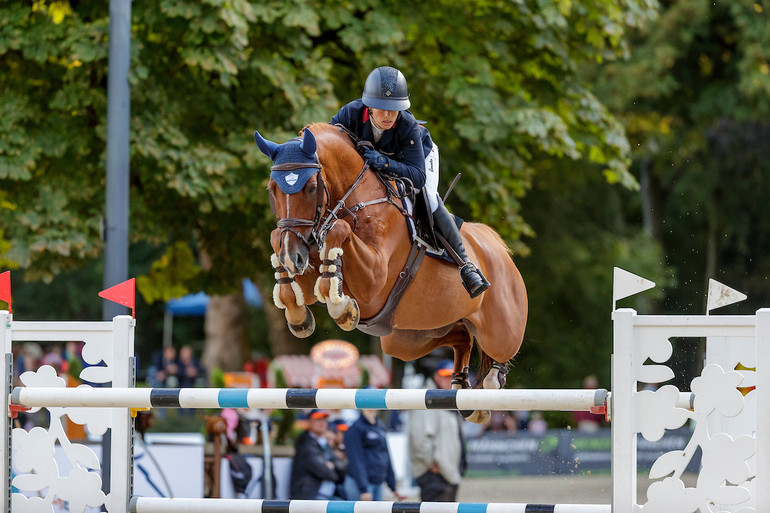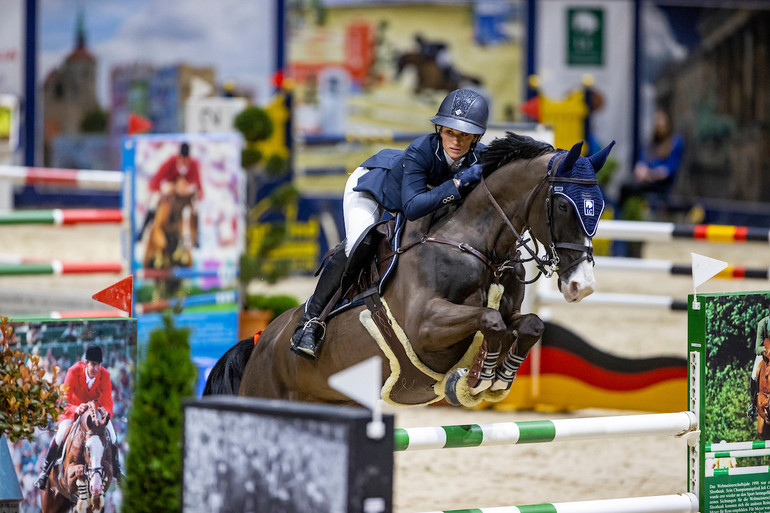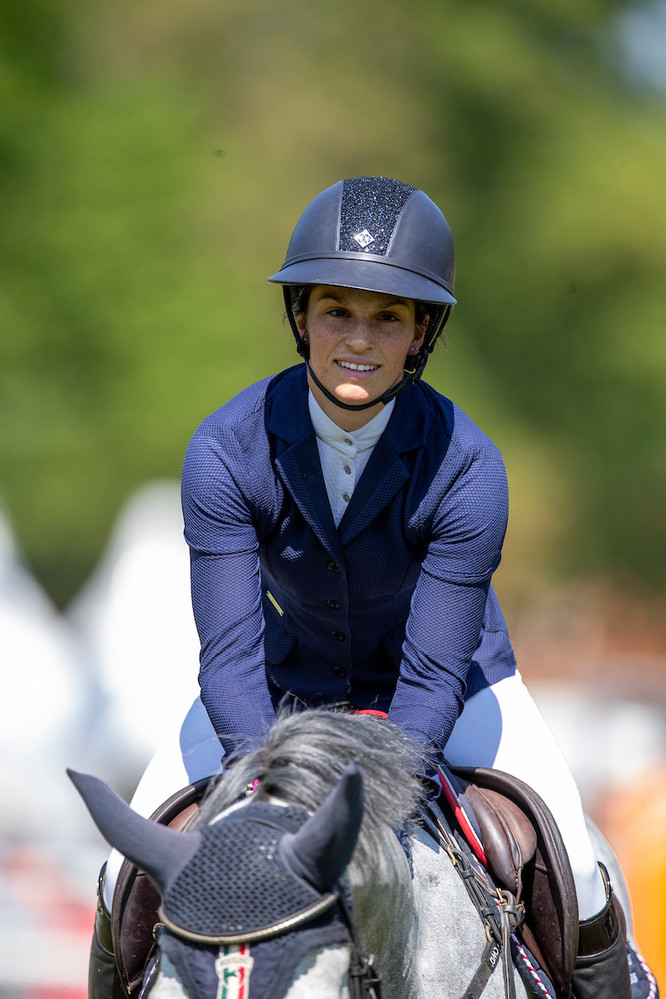Text © World of Showjumping
“You need strong work ethics,” Alexa Stais replies when asked about what it takes to move your way up the ladder as a young female rider in a competitive jumping and trading environment in Thedinghausen, Germany. “I’ll be in the stables for as long as it takes. I want to be the best I can be, and I want the same for my horses – so it’s not about when you finish, but how. You have to be passionate to succeed, and you need to be willing to take chances,” the 24-year-old South African rider says.
Stais knows what she’s talking about. After finishing school in South Africa at the age of 18, she came to Germany and started out with three months of grooming for Hans-Jörn Ottens before moving on to work for Hilmar Meyer.
Born in Johannesburg, Stais grew up in the horsey neighbourhood of Kyalami. Both her parents were hobby riders – and Stais got smitten early on with a local riding school just down the road from her home. “When I was seven, I got my first pony. We were lucky to have a few stables at home and a small ring,” Stais tells. “In the beginning, I did both jumping and vaulting. The vaulting quickly became serious. I did three World Equestrian Games, the first in Aachen in 2006 where I was the flyer and then as an individual in Kentucky in 2010 and in Caen in 2014. That same year, I also jumped at the Youth Olympic Games in Nanjing.”
Stais’ early commitment to vaulting took her to Europe at a young age. “From my first time in Aachen, I loved Germany,” she tells. “When I came over here to train, I spent a lot of time close to Hannover. That’s also how I got to know Hilmar better. We were looking to try out a new horse for me, and as Hilmar had a lot of contacts in South Africa we were recommended to go to him. At that time, I was 15 and Hilmar told me that if I ever wanted a job I would be welcome to his stable. When I was 18 and finished with school, I left for Germany,” Stais tells. “It was nothing else I wanted to do than this, and my parents were very supportive of my decision.”
“Obviously, it was a bit of a culture shock and quite daunting,” Stais laughs. “However, it was a good time to leave. I was young and had nothing holding me back. In my mind, I knew I would have to give myself at least a year to make it work – it was a new country, a new language and new people. In the beginning, I groomed for three months. At home in South Africa, I had of course been very involved with my own horses but not necessarily exposed to the hard work. I really enjoyed the grooming though. At Hilmar’s I got to ride more, mostly the dealing horses that passed through – but still kept on grooming for him in between. The year I arrived at Hilmar’s stable, I won my first S-competition and it gradually went from there – a year and a half later I received my ‘Goldenes Reitabzeichen’ from the German Equestrian Federation. But to this day, I am my own groom at the shows unless I go to a tour with a bigger team of horses. So, I’ll be in the stables early morning until it’s all done – and I like it!”
Currently, Stais has twelve horses in her string with the lead man being the 15-year-old Quintato. The gelding came to Stais when he was 13, and has been a late bloomer on the international circuit. “Hilmar had known Quintato for quite some time as he had been competing here in the area. When the chance came to buy him, he jumped on it. Quintato and I clicked straight away. It’s the kind of partnership, where I know that if I ride well he’ll jump clear. If I’m unlucky or make a mistake, I’ll have one down. For me as a rider it’s so important to have a horse like him, that is so consistent every time I go in the ring. He has helped me so much,” Stais tells.
“I also have Kia V, a 12-year-old mare, that works behind Quintato. I won the two-star Grand Prix in Salzburg with her last year, and I love her. She is a wonderful, chestnut lady,” Stais smiles. “Then there is Bjerglunds Cuba. With her, I qualified for the World Equestrian Games in Tryon but one month before she got injured. Now, she is finally back. She is not the easiest horse, she is by Clarimo and a bit mouthy – but she has the biggest heart and always fights for me.”
“I have some really nice up-and-coming seven and eight years old to ride too. I feel that it’s really important to always have a good and strong string of young horses behind my Grand Prix horses, because they are – of course – my future too. One of my biggest talents right now is Steenken. He is 1.58 tall with the biggest heart and stride! He is very sensitive, sfull of life and unbelievably careful – I think he’s one to watch for the future!” Stais tells.
Stais enjoys developing the young horses for the future, even though she is well aware that they sooner or later will find new homes. “I do accept that the horses need to be sold in order to keep the business here running. It’s so important to have a constant income to cover all the costs, and I know that. Hilmar usually finds the horses young – and a bit raw – and then we develop them for a year or two before they get sold. As long as they go to a good rider, I don’t mind. A horse like Chacco Top I would obviously have loved to have kept for myself, but it was also awesome to see him go and do so well with Jessica Springsteen as well as William Whitaker,” Stais tells.
Stais also tries to learn as much as possible from her boss about how to source out the younger horses. “Hillmar has a really good eye,” she says. “It’s easy to go shopping when you have a lot of money to spend, but to go find something really good for not too much – you have to know what you are doing. I enjoy learning from him, he is usually always right in what he sees.”
The Young Riders Academy has also provided Stais with some valuable lessons, through their educational program which she graduated from earlier this year. Furthermore, she’s been lucky to receive help from Tjark Nagel and tips from Helena Stormans. “Tjark comes here to help me every week or every second week. In between, Helena will watch my videos and come with input. She is very critical, she keeps me on my toes – which I like,” Stais smiles.
Last year was a good one for Stais. She won the two-star Grand Prix of Verden – her home show – with Quintato, the two-star Grand Prix in Salzburg with Kia and took big three- and four-star wins in Vilamoura and Salzburg. “Jumping the only double clear in the Nations Cup in Drammen in 2018 with Quintano 35 is another of my highlights,” Stais mentions. “And getting to jump the Hamburg Derby with Cuba when I was 21. I wasn’t very good, but I did it and would love to repeat it!”
Brave, determined, gutsy and hard-working. Stais has it all. Now she is looking towards the future, and dreams of competing in Aachen – again – and at the Olympic Games. “I was close to qualifying for Tokyo last year, but missed out narrowly in my group,” she explains. “I had my plan and tried to qualify through shows here in Germany, but several riders in my group competed in Damascus where there were more points to be gained. However, I will carry on – I am still young and there are more chances to come!”
“Doing this job, you have to be prepared that it’s a rollercoaster – there are more downs than ups,” Stais smiles. “The most important days are not the good ones. It’s the bad ones, because they will determine if you have the strength to carry on and pick yourself up when needed.”
No reproduction without permission, copyright © World of Showjumping











